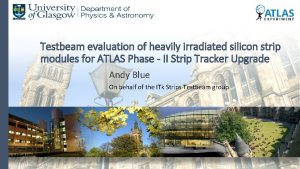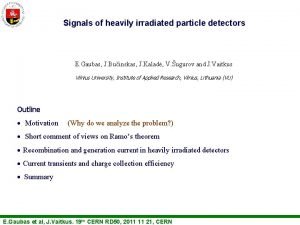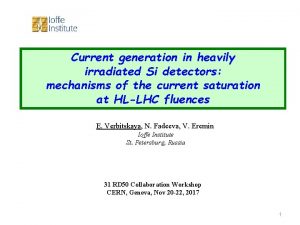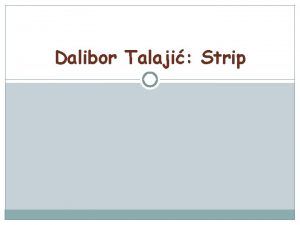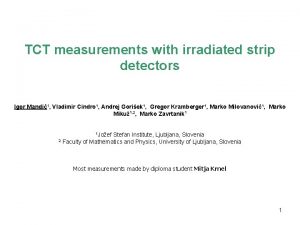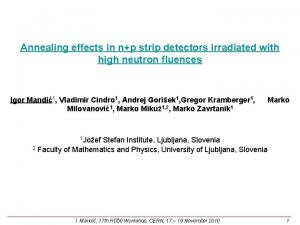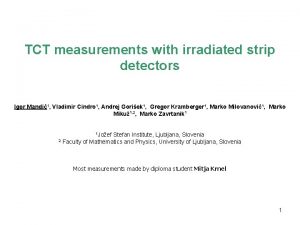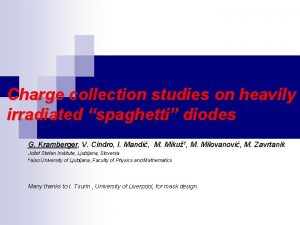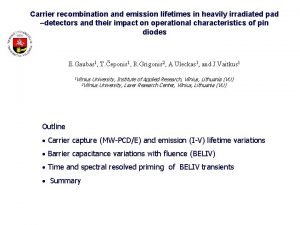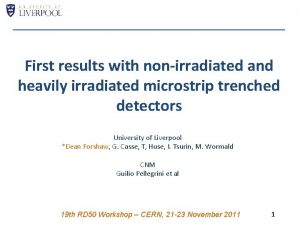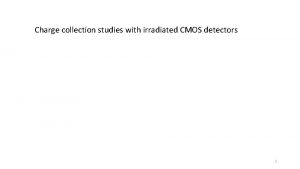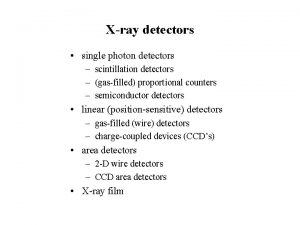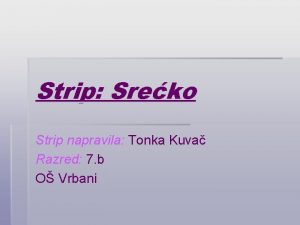EdgeTCT studies of heavily irradiated strip detectors V




















- Slides: 20

Edge-TCT studies of heavily irradiated strip detectors V. Cindro 1, G. Kramberger 1, A. Macchiolo 3, I. Mandić1, M. Mikuž 1, 2, M. Milovanović1, P. Weigell 3, M. Zavrtanik 1 1 Jožef Stefan Institute, Ljubljana, Slovenia 2 Faculty of Mathematics and Physics, University of Ljubljana, Slovenia 3 Max Planck Institute for Physics, Munich, Germany

Outline o Motivation o Samples, irradiations, annealing procedure o Experimental setup, extraction of charge collection and velocity profiles o Results - evaluation of induced signals, CC, velocity and I-V profiles, influence of annealing o Conclusions M. Milovanović, 7 th Trento Workshop, Ljubljana, SI, 29. 2. – 2. 3. 2012 2

Motivation Taken from: I. Mandić et. al. , NIM A 629 (2011) 101 -105 o Charge multiplication effects are observed in highly irradiated FZ p-type strip detectors after long annealing times. [Liverpool, Freiburg, IJS] o The idea is to examine where/when impact ionization takes place inside the detector and how multiplication affects the total charge collected. M. Milovanović, 7 th Trento Workshop, Ljubljana, SI, 29. 2. – 2. 3. 2012 3

Samples, irradiation and the annealing procedure Sample Fluence Annealing 1) HPK (ATLAS-07 run) Φeq=1· 1016 cm-2 Sequential steps (0, 10, 20, 40, 80, 160, 320, 640, 1280, 2560, 5120 min) at 60ºC up to a cumulative time of 10240 min. 1 x 1 cm 2, 300 mm thick Material/type: FZ, p-type initial Vfd~190 V 2) MPP/HLL (provided by MPI) cm 2, 1 x 1. 2 150 mm thick, bonded on low resistivity handle wafer Material/type: FZ, p-type initial Vfd~82 V (Fluence history: 1, 2, 5 · 1015 cm-2 with annealing up to 80 min. ) Φeq=5· 1015 cm-2 Sequential steps at 60ºC up to a cumulative time of 20480 min o Irradiations performed with 1 Me. V reactor neutrons at TRIGA (JSI, Ljubljana) o At each annealing step, measurements of collected charge and leakage current performed at bias voltages of up to 1000 V. o Annealing performed with the sample mounted inside the setup o Stable position/laser (the same spot illuminated each time) o Sample temperature stabilized to less than 1ºC M. Milovanović, 7 th Trento Workshop, Ljubljana, SI, 29. 2. – 2. 3. 2012 4

Edge-TCT setup T=-20°C laser • 1064 nm • 100 ps pulse • 200 Hz – 1 MHz repetition lens system o o o 1. 5 GHz scope detectors on a Peltier cooled support in dry air atmosphere (down to -20 o. C) Position of e-h generation controlled by 3 sub-micron moving tables (x, y, z) The amount of injected charge and frequency can be controlled (laser tune and frequency=200 Hz kept constant during these measurements) Absolute charge measurements are very difficult to achieve, therefore arbitrary units used for collected charge. M. Milovanović, 7 th Trento Workshop, Ljubljana, SI, 29. 2. – 2. 3. 2012 5

Charge collection and velocity profiles HPK, non-irradiated @200 V CHARGE COLLECTION PROFILE Vfd~190 V VELOCITY PROFILE charge collection for mip M. Milovanović, 7 th Trento Workshop, Ljubljana, SI, 29. 2. – 2. 3. 2012 6

HPK – Φeq=1∙ 1016 n/cm 2, no annealing @800 V M. Milovanović, 7 th Trento Workshop, Ljubljana, SI, 29. 2. – 2. 3. 2012 7

HPK – Φeq=1∙ 1016 n/cm 2, tann=0 ÷ 80 min o Beneficial annealing (after 80 min at 60ºC) of space charge and trapping times of electrons observed and found for both junctions. o The annealing effect is not very significant, though it should be noted that annealing was already taking place during previous irradiation steps. M. Milovanović, 7 th Trento Workshop, Ljubljana, SI, 29. 2. – 2. 3. 2012 8

HPK – Φeq=1∙ 1016 n/cm 2, min tann=0 ÷ 10240 Nearly 3 x increase! o o o During long-term annealing, up to a total of 10240 min. at 60ºC, a nearly threefold increase in CC in the region near the strips (highest E). Increase due to space charge concentration rising near the n+-p junction with the annealing, leading to a substantial increase of E (E>~12 V/μm) where the impact ionization takes place (between 320 and 640 min). If the voltage and thus E is not large enough to start impact ionization, CC decreases due to long-term (reverse) annealing. M. Milovanović, 7 th Trento Workshop, Ljubljana, SI, 29. 2. – 2. 3. 2012 9

HPK – Φeq=1∙ 1016 n/cm 2, tann=0 ÷ 10240 min. Only an approximate method! QM@10240 min QM@2560 min QEXT@10240 min o o o The contribution of charge multiplication to CC/<Q> was estimated by subtracting the measured values of CC at 800 V with extrapolated values from the lower voltage CC curves linear fit to 800 V (<Q>M - <Q>EXT). By plotting the dependence of CC contribution on annealing time and fitting the values with 1 -exp(-t/τY), a time constant of 3000÷ 5000 min is obtained. Time constants for ∆Neff and ∆<Q> are the same order of magnitude, supporting the assumption that Neff increase causes greater impact ionization. M. Milovanović, 7 th Trento Workshop, Ljubljana, SI, 29. 2. – 2. 3. 2012 10

HPK – Φeq=1∙ 1016 n/cm 2, o o tann=0 ÷ 10240 min. The initial beneficial effect of annealing clearly noticed up to ~100 min, later drop due to long term annealing effects, until the onset of multiplication. Charge multiplication noticed even at 400 V after the final annealing step! Strong correlation with the leakage current – beneficial effect until the onset of multiplication at 1000 min, following the pattern of increasing CC. Charge multiplication is also clearly recognized in the induced current pulse shapes measured at different depths. M. Milovanović, 7 th Trento Workshop, Ljubljana, SI, 29. 2. – 2. 3. 2012 11

HPK – Φeq=1∙ 1016 n/cm 2, tann=0 ÷ 10240 min. @800 V o The first peak, associated with the initial drift of primarily generated carriers (from the laser) widens up to a point where the second peak, coming from the multiplied carriers, becomes more apparent and the dominant one. o This can also be observed in CC profiles for different bias voltages: as the bias increases, E becomes large enough to invoke multiplication over a larger area inside the detector. M. Milovanović, 7 th Trento Workshop, Ljubljana, SI, 29. 2. – 2. 3. 2012 12

HPK – Φeq=1∙ 1016 n/cm 2, tann=0 ÷ 10240 min. @800 V =0 . in m n t an 0 24 0 >1 . in m t ann o o o The velocity profile points to the reduction of the high E region in the detector with annealing time. The drift velocity close to the strips is almost saturated, while in the rest of the detector is smaller for longer annealing times, implying that E close to the strips must increase. Confirmation of assumed space charge development with LT annealing. The correlation between the current and CC is near linear => thermally generated carriers undergo the same effect. M. Milovanović, 7 th Trento Workshop, Ljubljana, SI, 29. 2. – 2. 3. 2012 13

MPP/HLL – Φeq=5∙ 1015 n/cm 2, tann=0 ÷ 20480 min (150 μm) Thanks to: Philipp Weigell and A. Macchiolo, MPI Nearly 15 x increase! o o Initial Vfd≈82 V. Estimated Vfd after irradiation and 80 min of annealing: ~1500 V. Charge multiplication contribution to CC ~15 x after 20480 min! (the detector still under study – currently annealing to 40960 min!) Charge multiplication noticed even at 250 V after the final annealing step! M. Milovanović, 7 th Trento Workshop, Ljubljana, SI, 29. 2. – 2. 3. 2012 14

MPP/HLL – Φeq=5∙ 1015 n/cm 2, tann=0 ÷ 20480 min (150 μm) Thanks to: Philipp Weigell and A. Macchiolo, MPI @900 V – 80 min @900 V – 10240 min @900 V – 5120 min @900 V – 20480 min M. Milovanović, 7 th Trento Workshop, Ljubljana, SI, 29. 2. – 2. 3. 2012 15

MPP/HLL – Φeq=5∙ 1015 n/cm 2, tann = 20480 min (150 μm) Thanks to: Philipp Weigell and A. Macchiolo, MPI @200 V @250 V @300 V M. Milovanović, 7 th Trento Workshop, Ljubljana, SI, 29. 2. – 2. 3. 2012 16

MPP/HLL – Φeq=5∙ 1015 n/cm 2, tann=0 ÷ 20480 min (150 μm) Thanks to: Philipp Weigell and A. Macchiolo, MPI M. Milovanović, 7 th Trento Workshop, Ljubljana, SI, 29. 2. – 2. 3. 2012 17

MPP/HLL - Φeq=5∙ 1015 n/cm 2, HPK – Φeq=1∙ 1016 n/cm 2 - Comparison with HPK - Φeq=5∙ 1015 n/cm 2, measured with SCT 128 by I. Mandic Edge-TCT MPP/HLL - 150μm HPK - 300μm Φeq=5∙ 1015 Φeq=1∙ 1016 n/cm 2 SCT 128 HPK - 300μm n/cm 2 Edge-TCT SCT 128 MPP/HLL - 150μm HPK - 300μm Φeq=5∙ 1015 Φeq=1∙ 1016 Φeq=5∙ 1015 n/cm 2 M. Milovanović, 7 th Trento Workshop, Ljubljana, SI, 29. 2. – 2. 3. 2012 18

MPP/HLL – Φeq=5∙ 1015 n/cm 2, tann=0 ÷ 20480 min (75 μm) Thanks to: Philipp Weigell and A. Macchiolo, MPI

Conclusions o Charge collection efficiency increases with long-term annealing for highly irradiated (Φeq ≥ 5∙ 1015 n/cm 2) p-type strip detectors due to increased space-charge concentration, hence the electric field in the strip region, consequently leading to the effect of multiplication even at voltages as low as a few hundred volts. o Long term annealing shifts the multiplication mode of operation towards lower bias voltages, because it increases the space charge concentration near the n+-p junction. o Even at high fluences, the detector remains active throughout the whole volume. o The leakage current shows strong, near linear correlation with the charge multiplication. o Measurements of Edge-TCT and SCT 128 are compared and validated. Thank you for your attention! M. Milovanović, 7 th Trento Workshop, Ljubljana, SI, 29. 2. – 2. 3. 2012 20
 Irradiated food symbol
Irradiated food symbol Irradiated food
Irradiated food Giant wave detectors murmurs universe
Giant wave detectors murmurs universe Diagnosing error in object detectors
Diagnosing error in object detectors Wave could hear murmurs across universe
Wave could hear murmurs across universe Photo detectors
Photo detectors Feature vectors
Feature vectors Photo detectors
Photo detectors Nuclear detectors
Nuclear detectors Feature detectors
Feature detectors Streaming current detectors
Streaming current detectors Where are feature detectors located
Where are feature detectors located Hplc detector types
Hplc detector types Frontier detectors for frontier physics
Frontier detectors for frontier physics Vhv voltage detectors
Vhv voltage detectors Feature detectors ap psychology
Feature detectors ap psychology Paradigm shift from women studies to gender studies
Paradigm shift from women studies to gender studies Why do runners breathe heavily after a sprint race
Why do runners breathe heavily after a sprint race The mycenaeans borrowed heavily from this culture
The mycenaeans borrowed heavily from this culture Gre exam syllabus
Gre exam syllabus Formalism definition literature
Formalism definition literature






















